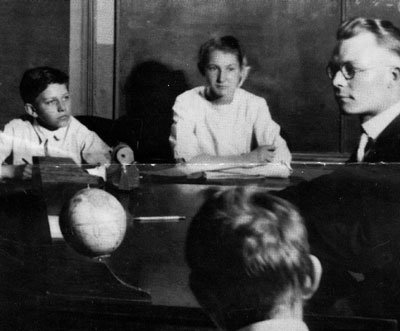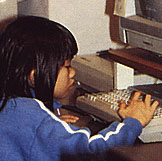

The story of LCMS deaf missions begins in the period following the American Civil War. Lutheran congregations involved in the efforts to provide homes for children left fatherless by the war established the Lutheran Children's Friend Society. In 1873, Rev. J. A. Heugli led the efforts of Christians in the Detroit area to establish an LCFS orphanage. The board called as the orphanage's first director Rev. George Speckhardt, who was serving a Michigan Lutheran parish further north. Rev. Speckhardt, himself an orphan, was well suited for the post. But with him came a little surprise.
Prior to becoming a pastor, Rev. Speckhardt had been a teacher for the deaf in Germany. When he was later serving as a parish pastor in Michigan, he discovered two deaf girls, daughters of Lutheran parents. So he added to his pastoral duties the tutoring of these two girls.
When Pastor Spechardt received the call to become the director of the Detroit orphanage, both he and the parents of the deaf children were concerned about the girls' education. They asked the board of the orphanage to allow these two deaf girls to reside at the orphanage so they could continue their schooling. The board agreed, and soon word spread to other families of deaf children.
Within one year the board realized that they had an unexpected opportunity for ministry. After weighing their options, they decided to reorganize the orphanage as the Lutheran Institute for the Deaf, and to transfer the orphans who were first resident there to a sister facility near Chicago.

Twenty years after the founding of the deaf school in Detroit, one of it's graduates, Edward Pahl, enlisted the help of the school's director, Daniel H. Uhlig, to address the spiritual needs of deaf adults. Director Uhlig alerted Rev. Augustus Reinke of (First) Bethlehem Lutheran Church of Chicago, who, in turn, met with Mr. Pahl. By their combined efforts, Reinke and Pahl started congregational ministry for Deaf people on Sunday March 4, 1894. Within two years, Pastor Reinke also ministered regularly to Deaf people in Milwaukee, St. Louis, Louisville, and many other cities.
The 1896 convention of the Lutheran Church - Missouri Synod in Fort Wayne, Indiana, had the opportunity to witness the fruit of Pastor Reinke's ministry, as he led worship in Sign, assisted by deaf members of his congregation. During that convention, Synod adopted Deaf Missions as an official mission program of Synod. Pastor Reinke was elected chairman of the new board, and wthin six months four other men were called to work full-time with Deaf people.
The Deaf mission program was administered by a separate board from 1896 until 1965. During that time also it was responsible for Blind Ministry until it had a separate board in 1949.
In 1965 Deaf Missions became part of the unified Board of Missions. Synod, at New Orleans in 1973, voted to transfer the administrative responsibility to the Districts of Synod and to retain responsibility for policy and training of professional workers.
Deaf congregations and their pastors began meeting together in regional conferences in 1949. The North Atlantic Deaf congregations met in 1950 to draw up plans for a missionary society later known as the Lutheran Deaf Mission Society. This LDMS helped with the beginning of work with Deaf persons in the Orient. 1969 History of Deaf Missions, Dr. Augustus Suelflow

In 1971, Deaf people established the International Lutheran Deaf Association for the purpose of "Sharing the Good News with Deaf People through fellowship and leadership training." The Deaf Mission Society and The Deaf Lutheran became a part of that organization. The International Lutheran Deaf Association raises about $25,000 every two years for mission projects over and above regular congregational missions.
In 1994, the LCMS had 63 primarily Deaf congregations in 25 states served by 30 full-time pastors or missionaries, plus three pastors in part-time deaf ministry. About 200 "hearing" congregations had regular interpreted ministry for Deaf persons; less than a half-dozen of the pastors of those hearing churches are able to Sign. Profoundly Deaf communicant members in the LCMS numbered about 8,000. In 2012, we have lost many of our congregations and pastors. Directory of LCMS Deaf Missions
Lutheran Deaf schools exist in Brazil (2), Hong Kong (1), India (4), and Macau (1). In addition, Deaf adult missions have started in Ghana (1), Hong Kong (2), India (1), as well as Australia (1), and Norway (1).

The Concordia Theological Seminary, Ft. Wayne, offers courses which expose students to the church's need for deaf missions and various models for meeting those needs. The seminary also supports hearing churches with interpreted ministries through its summer Church Interpreter Training Institute (CITI).
Concordia Seminary, St. Louis, similarly provides language training to both students and members of the community through the Seminary Sign School. And the seminary is home to Synod's Deaf Institute of Theology (DIT), which enables deaf Lutherans receiving mentored training for service in their home congregations.

The Lutheran Church - Missouri Synod has enjoyed a long and fruitful ministry among Deaf people, sharing the Good News of God's love and forgiveness in Jesus Christ with those whose primary mode of communication is Sign. One of the unique strengths of the mission has been the leadership of Deaf Christians in the ministry. In 1959 Rev. William Ludwig became the first Deaf Lutheran to graduate from the seminary and receive ordination into the pastoral ministry. Many other Deaf people have followed his lead, as they have given themselves to the Gospel ministry as pastors, teachers, parish assistants, and foreign missionaries.